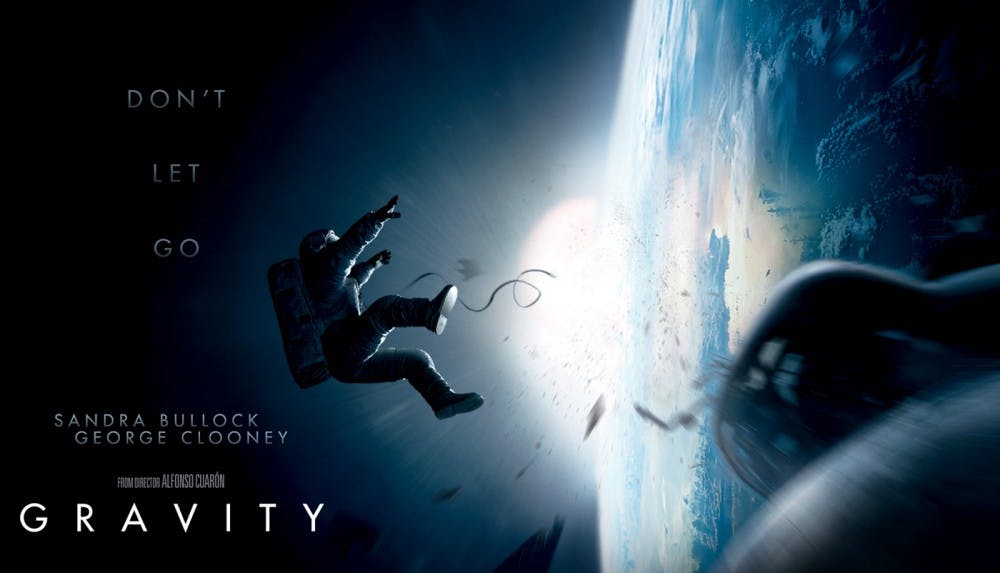‘Gravity’ takes breath away with stunning, single-shot visuals
4.5/5 Stars
Oscar-nominee Alfonso Cuarón (“Y Tu Mamá También,” “Harry Potter and the Prisoner of Azkaban”) is the front-runner to win Best Director at next year’s Academy Awards for his extraordinary science fiction film “Gravity.” Ryan Stone (Sandra Bullock) is a medical engineer on her first mission into space. After only a few months of training, she is sent up to do some technological work and is accompanied by seasoned astronaut Matt Kowalski (George Clooney). All seems to be going well as the devilishly charming Kowalski tells rowdy stories and listens to country music while the no-nonsense Stone is trying to do her job. Suddenly, Houston warns them that debris from a Russian anti-satellite test is headed toward them. The debris smashes into the spaceship and sends even more debris whizzing around the helpless humans. Within the first 20 minutes of the film, Stone and Kowalski are stuck floating out in space alone. She has less than ten percent of oxygen left in her suit.
“Gravity” is one of the most technologically astonishing feats of filmmaking in cinema history. Part of me wants to know how all of the special effects were created but another part of me does not, wanting to preserve the spell the film casts. The film is a sci-fi drama thriller that completely transports the spectator and remains unbelievably thrilling and nerve-racking for its 90-minute running time. The characters’ fear and anxiety are not just seen and heard but experienced. One of the reasons the film is so heart-stopping and intense is because much of the film seems to be taking place in real time. The director, Alfonso Cuarón, has many shots in the film that go on for several minutes without a cut. The opening shot of the film is 17 minutes. By staying on the characters and following their movements without cutting, the film builds a focused urgency that makes the spectacular action believable and potent. When there are only one or two characters on screen for almost the entire film, there is no reason to constantly cut. The long shots capture the loneliness and helplessness of the characters.
I think 3-D is overused, misused and a gimmicky waste more often than not, but Cuarón, his cinematographer, Emmanuel Lubezki, and the hundreds of special effects artists that worked on the film make the 3-D totally immersive. Halfway through the film, I suddenly realized I was watching it in 3-D. I had been so enraptured by the film’s story and visuals that I forgot about the 3-D and the glasses. Having seen the film in that format, I can’t imagine the film in 2-D. The film was designed to be seen in 3-D, and it is one of the best uses of it I’ve ever seen, so spending the extra money is justified. Seeing it in IMAX, like I did, only adds to the experience, too.
The film is so revolutionary, not only because of all of the technology and special effects that have never been used before, but because of the way the film tells the story visually. Usually a film is shot with the characters moving left and right, forward and backward, and the camera follows their motion within the frame. The frame is full of boundaries and confines such as walls, floors, ceilings, furniture, streets and cars. In space, the “world” of the film is everywhere and in all directions and there are a limited number of objects on screen to compare distance and placement.
Because so much of “Gravity” has the characters stranded in the vastness of space, the camera is untethered and often floating as if in zero gravity like the characters. Many shots in the film feel like they could be from the point of view of another astronaut.
In one ingenious scene, the camera shows an extreme close-up of Stone’s face soon after she is first cast adrift in space, and after many seconds of seeing the terror in her eyes, the camera turns within the same shot and becomes a perspective through her helmet and shows her spinning head over heels repeatedly and without any control over her movement. This dizzying shot is one of the examples of how the film would not be the same in 2-D. It is not only that the shot shows what she is seeing out in space, but the added dimension shows what looking out through the helmet looks like. Shooting through the clear material of her helmet in 3-D captures her depth of vision and creates a claustrophobic prison around her. The canvas on which the film is set is so huge, but much of the action is concentrated and specific. The film is always focused on the characters and their relationship to their boundless surroundings. That makes the 3-D camera work an integral part of the film.
Cuarón, whose last feature film, “Children of Men,” came out seven years ago, spent more than four years making this film. He wrote this labor of love with his son Jonás. Those who care about cinema and about art need to run out and see this film in 3-D on a big screen. It is easily one of the best films of the year and one of the best science fiction films of all time.

